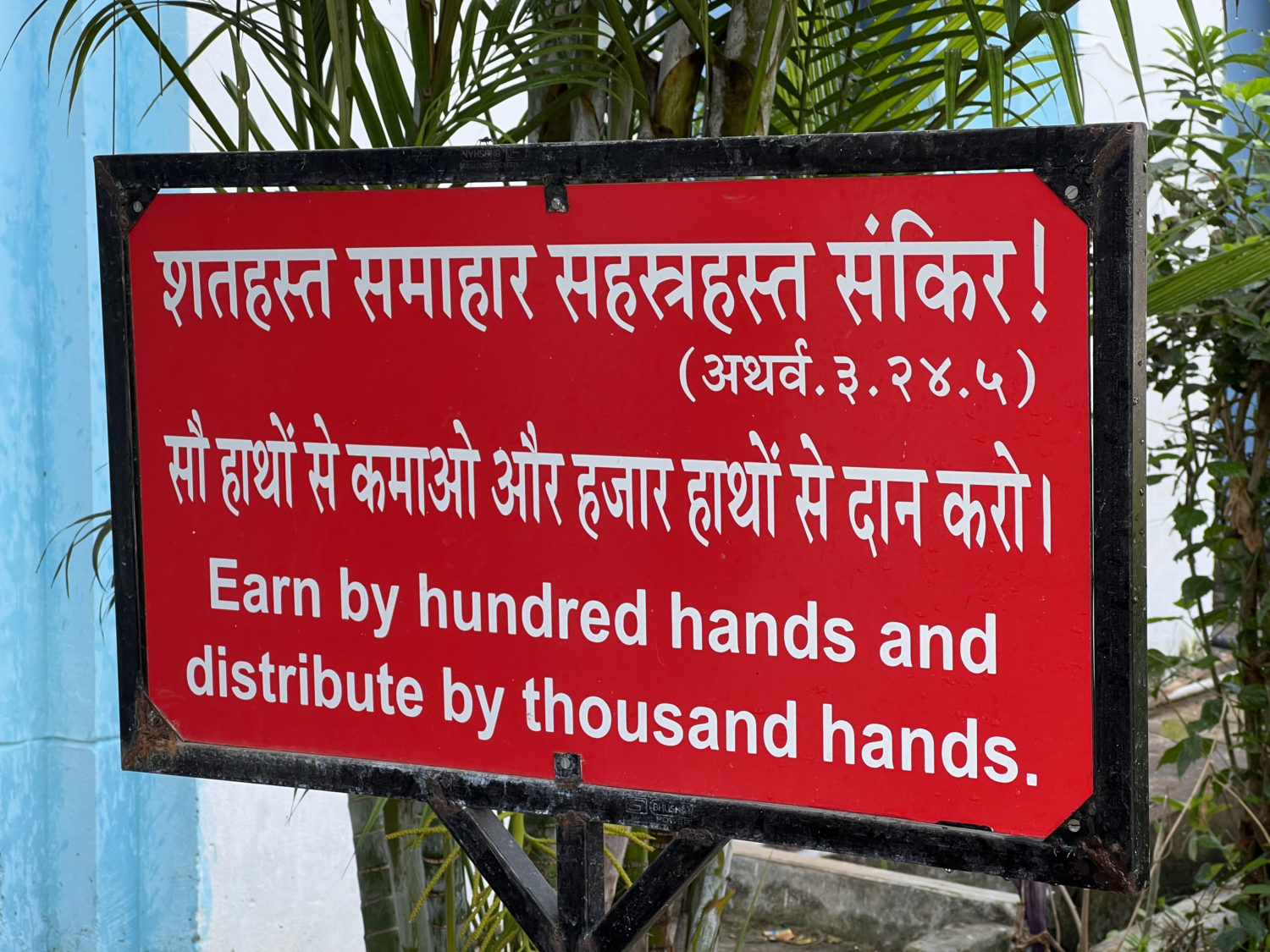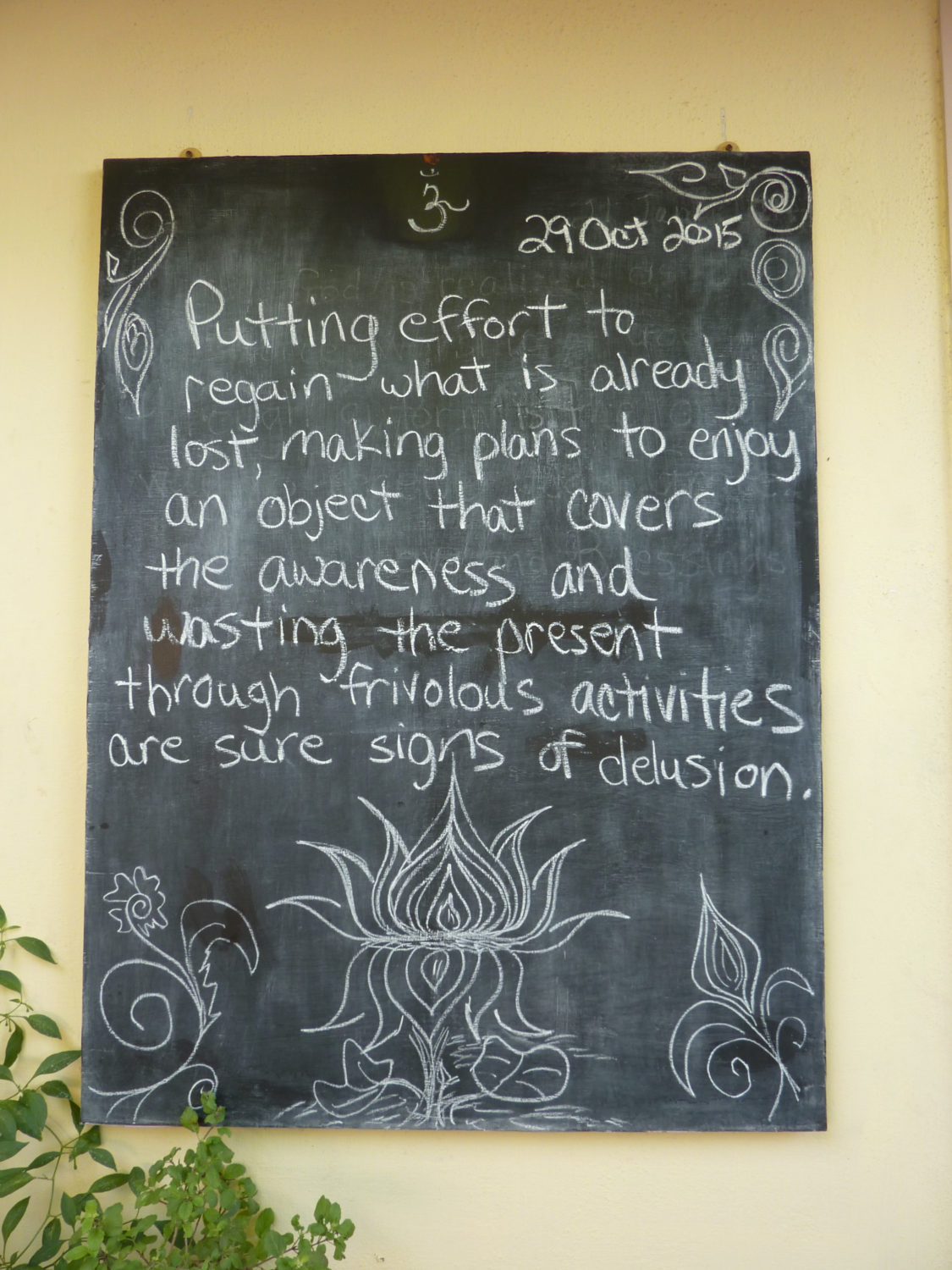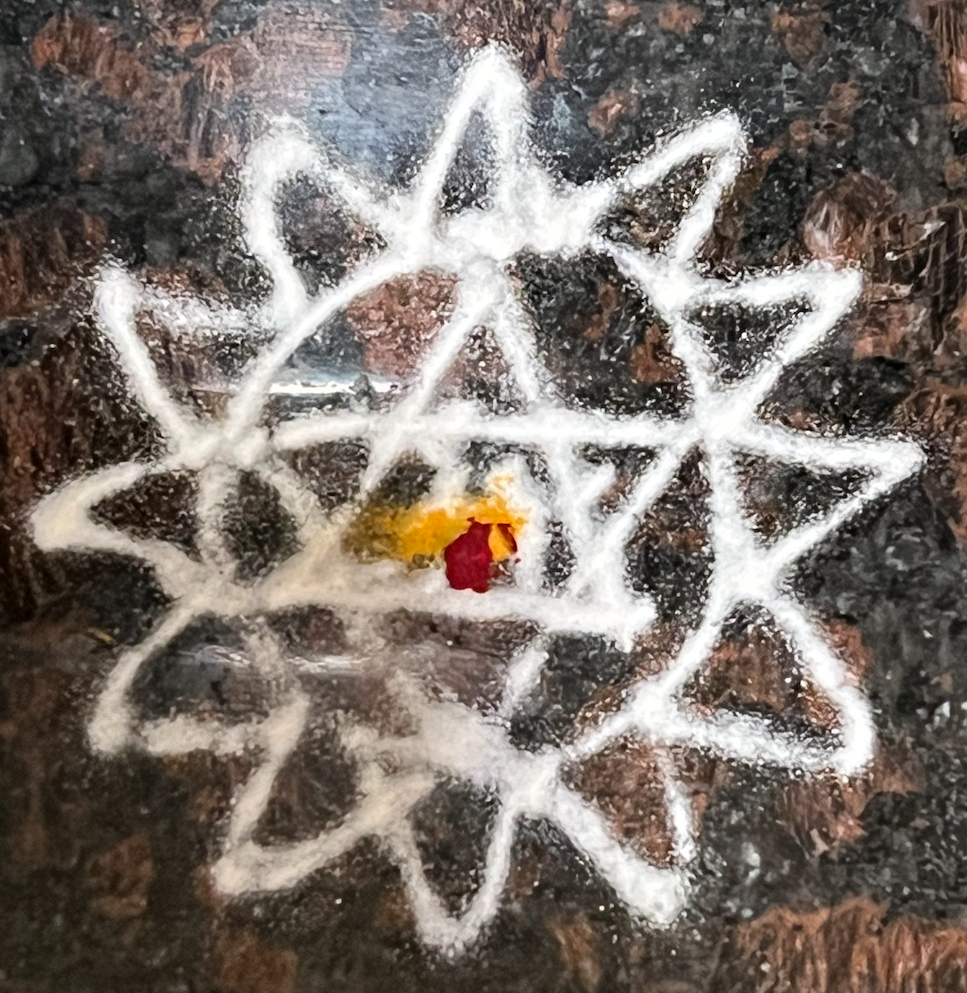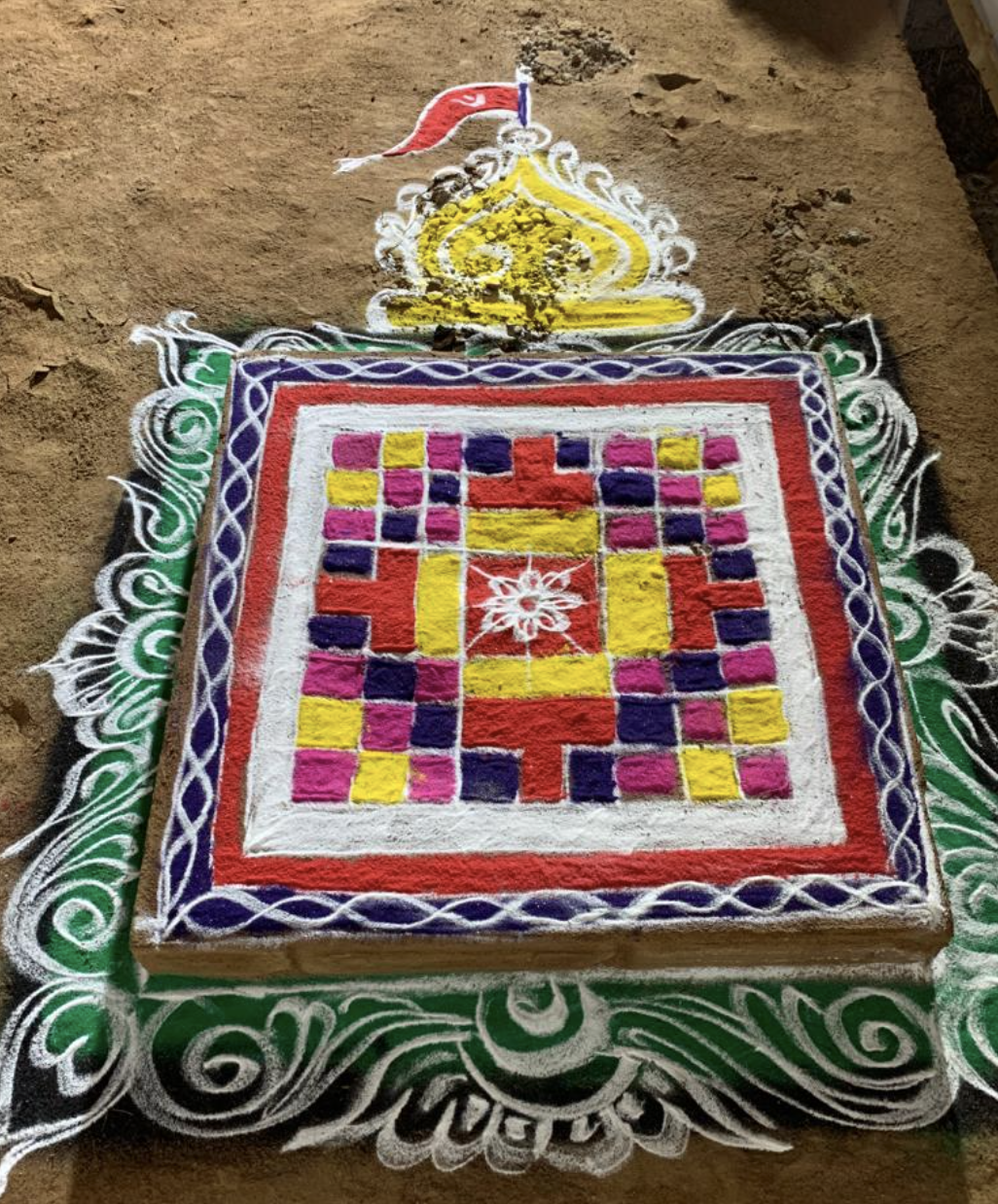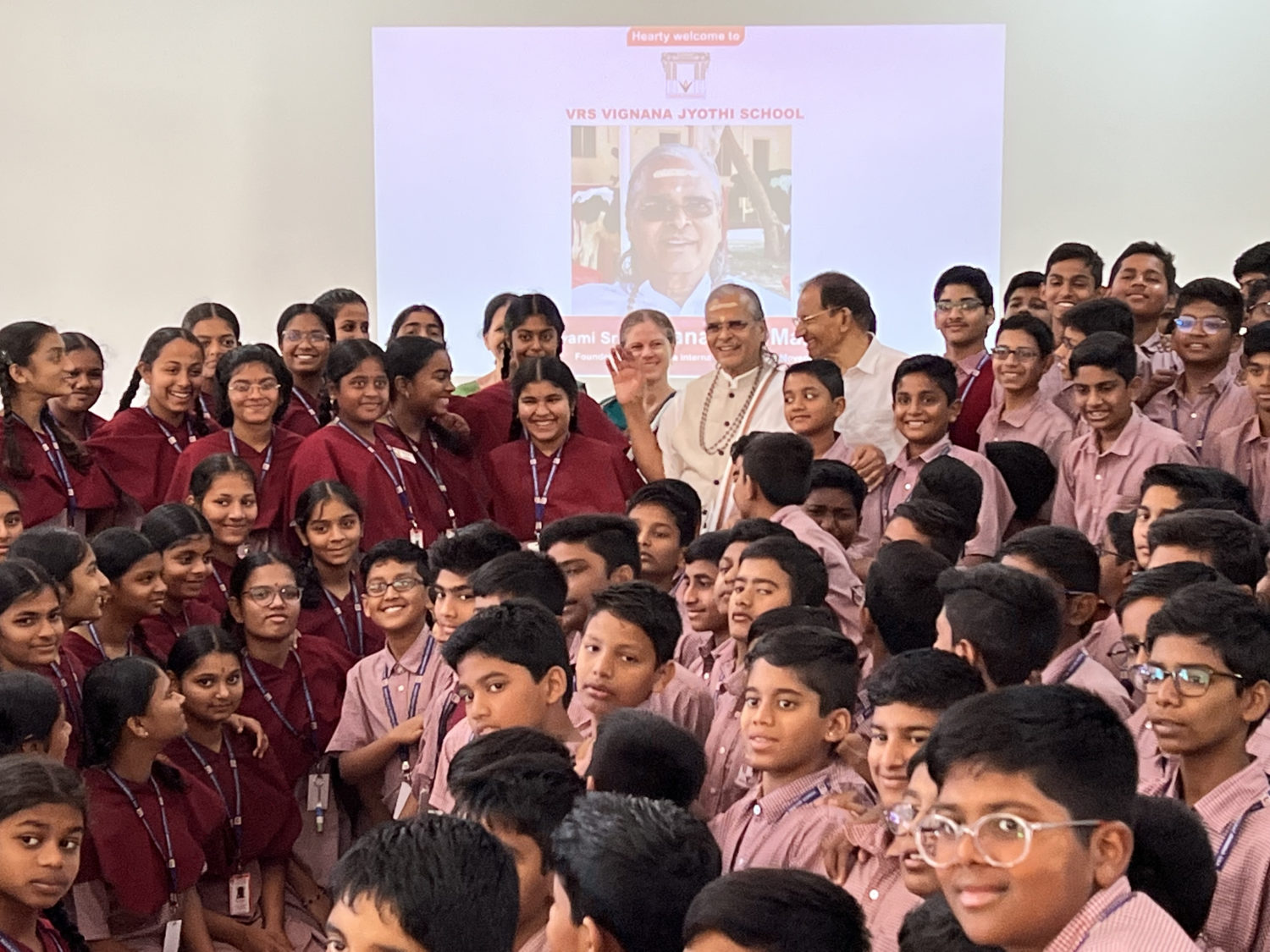Omm Namo Bhagavate
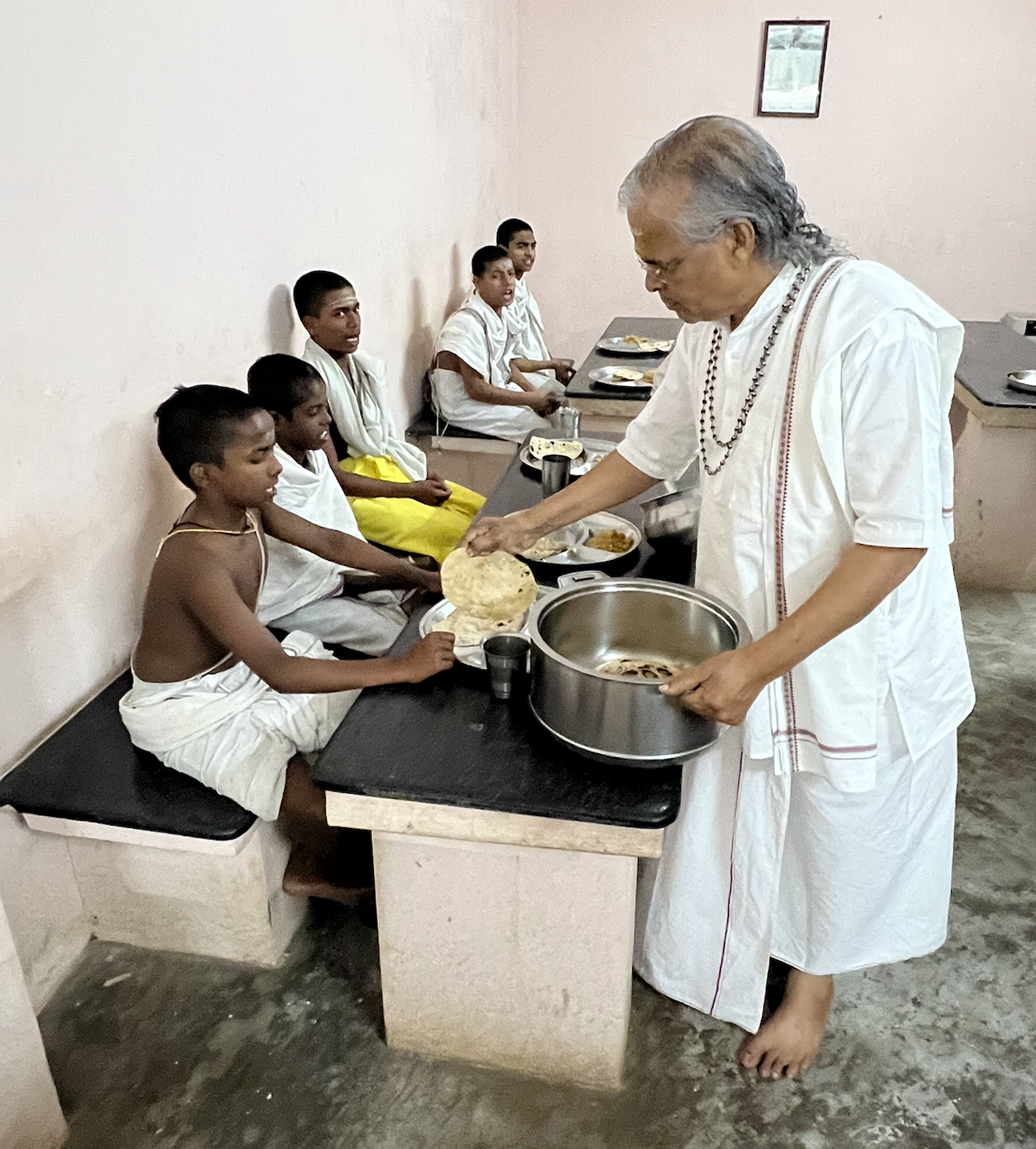
Today I will explain Verse 125, the sixth verse of the third chapter. It has a connection with the previous verse: No one can ever remain inactive even for a moment, because all are helplessly driven to action by the modes of prakriti.
The purusha is helpless until it is liberated. This helpless purusha is a slave to prakriti, so whatever prakriti commands, the purusha has to give consent. Through the purusha, prakriti does what the purusha once upon a time wanted to do but could not, so it got stored up.
Prakriti has no will and purusha has no power, actually. The purusha desires everything, without having the capacity for anything. The purusha desires because in order to experience prakriti, the purusha entered the world of maya. What is there to be experienced in prakriti? Only two things: prakriti’s beauty and prakriti’s mystery. Prakriti changes herself in variable ways so that the purusha can experience prakriti in her expanded, extended state, but because purusha is purusha, a time comes when the purusha gets fed up with these repetitive experiences, and wants to go back to its original state. At that time prakriti does not allow that. She does something so that the purusha is again diverted. How she does it, the purusha is not able to know. That prakriti is doing it, purusha is able to know, but the purusha knows this only after losing its identity. Repeatedly the purusha goes through this crisis and knows, “Again I got trapped and again I got veiled.” But how prakriti is doing this, the purusha is not able to know, because that’s the mystery.
The purusha gets fed up with this beauty aspect and becomes determined to penetrate through the mystery of prakriti—how she is doing what she is doing. She is only veiling, trapping and clouding, so that the purusha is losing its awareness. Until and unless the purusha becomes one-pointed to know how prakriti is doing what she is doing, yoga is not possible. Here yoga refers to jñana yoga. Jñana is not possible until the purusha is determined to know how prakriti is doing and how she is veiling: “I was so alert, I was so determined, but again I fell into the trap. How did she do it?”
This mystery goes on and on. Lord Krishna now shows the way out. The first thing he says in verse 125 is that one who outwardly restrains the organs of action but mentally dwells on the objects of senses is verily deluded and is a hypocrite. Anybody can understand what is expressed here, but something is also implied and hidden, and that is to be brought out first.
The normal state of man is to run towards experience and enjoyment, and Gita says there is nothing wrong in that. To run towards objects of pleasure is the natural dharma of the embodied being, because it was for that purpose only that the being entered the body. The purpose was to experience the beauty and mystery of prakriti.
As per Gita, experience is an absolute term, not a relative one. Because of ignorance, man is viewing experience as a relative term and labeling it as good experience, bad experience, pain and pleasure. Experience is experience. Don’t attach any normative or value sense to it. Go through it. For example, if we are driving to a distant place, and it is a long ride through a village road, and the road is uneven, there will be vibrations and jerks. If one of the passengers says, “This is bad, this is bad, I am not going,” and gets down from the vehicle, then he cannot reach the destination. This so-called “bad” will not be lasting until the end. It’s just a bumpy road. Neither the driving nor the car nor the driver is bad.
Similarly, while taking the purusha through the journey, prakriti will sometimes steer the wheel of life through a bumpy road. At that time the experience will be different, and although we may give it a qualitative label like “bad” or “painful,” it is just a different experience.
The embodied being gets identified with the so-called good experience and wants that always, but prakriti is beauty, and beauty means variety. Without variety, there is no beauty. If prakriti always remains the same in every situation that beauty will be gone. Prakriti is variety, so first the experience will be of one type, and then after some time it will switch to a different type. But this purusha clings to the experience that appeals to it, and when a different experience comes the purusha grumbles and says, “I want that other experience.” For prakriti to give the same experience to purusha, prakriti has to change the gear to reverse and go backwards, but the law of life is always a forward march. It has to move continuously upward, so that the journey comes to an end from where it began. It is like a circle. Life’s wheel is constantly moving, and it should move. That’s the purpose.
Prakriti’s target is for the purusha to reach its goal. Reaching the goal means coming back to the point of origin, and the point of origin is the awareness, because the purusha is awareness. The awareness started its journey in the zone of experience, and in the beginning the awareness was more, and experience was less. Then the awareness gradually reduced while the experience grew. That’s the natural way. If you are not prepared to lose a portion of your awareness, you cannot gain the experience.
More experience means less awareness. This is why when you begin from the topmost point and descend, when you are coming right to the bottom point, at that time your awareness is gone. It is circular. When you reach the bottom point, awareness is gone and you are experience. That is why you say, “I am happy, I am sad, I am frustrated, I am depressed.” That indicates total delusion. Delusion is all experience, no awareness. At this point, half of the journey is complete. Next the ascending phase will begin again, back to the point of origin, to full awareness.
When you begin the upward the journey on the other half of the circle, you are leaving behind some of your experience and entering into awareness. Life’s path is always a circle, and it has four stages. According to Gita, these four stages are brahmin, warrior or kshatriya, merchant, and sudra or service. The four stages of life do not mean four classes; they refer to four stages of evolution. Yoga starts only when the beginning phase of brahmin comes; that is the awareness and the awakening.
Natural law says man will always expand in the experiential zone. However, in this liberal time, knowledge is available more freely than light from the sun, and man is receiving many things in his mind, and desiring that for which the time has not come. His inner evolution has not yet come to that stage. It is like if an eight-year-old girl will want to become a mother, because she read many things about the joys and prestige of motherhood, but she is eight years old. In yoga, ninety-nine percent of the people have this problem. They have more theoretical knowledge on yoga, without coming to the natural evolutionary phase to enter into the process called yoga. That is the hidden point that Krishna is trying to bring out, regarding one who outwardly restrains the organs of action, but inwardly dwells on object of enjoyment. If the circle is not complete, some of the residue desire to experience is still there, but due to too much bookish learning, or too much transmission of the outer knowledge, the man will think experience to be bad.
Why did Krishna not reveal Gita to Yudhishthira, who was the embodiment of pure sattwa, or to Bhima, who was in higher rajas and could achieve everything by effort? Instead, he chose someone in the transition phase of experience and awareness, who was fully a householder. This is very symbolic, and shows that you must have come at least halfway through the circle of life before you can really enter into yoga. Until you have transcended the whole process and completed the journey, and you are above this circle—neither in the ascent nor descent phase—you cannot know which point is the point of origin. That is why every point in the circle can be the point of origin. Only after transcending maya you will be able to see at what point the circle began. That is the sadguru. The sadguru is able to see the soul’s evolution, and whether the ascending phase has begun, or the descending phase is continuing. This is the reason every enlightened being, if they are truly enlightened, always has said, “Take it in a natural way. In the course of time, at the right time, you will realize the being.”
The implication of this verse is that it is natural for the senses to run towards the objects. If you have entered into the yoga path, my experiential advice is that if you fall even after taking a resolve that you will not do something, don’t think that yoga is not possible for you. Rather, recognize that some of this unfulfilled desire is still within you, and you have to go beyond it. You don’t know how much is there—it may be one ton or a hundred, or it may be an ounce. You cannot know. Gita says you have to constantly apply your discrimination, and through that your awareness will expand. When awareness expands, experience is automatically absorbed, like blotter paper absorbing ink.
You must reach that stage where you are able to see whether your awareness is swallowing the experience, or your experience is swallowing the awareness. If your experience is swallowing your awareness, you have not actually entered into the phase of yoga. Yoga will wait. Acquire knowledge about yoga, and get ready for it, but don’t give yourself credit that you are a yogi. Be truthful. Gita says one who is not truthful is a hypocrite. In yoga, hypocrisy is a cup of poison, because it will not allow you to see your inner state.
Sri Aurobindo has written this beautifully in The Mother, that when hypocrisy comes the tendency will be to hide under subterfuges, to rationalize, and to pass the blame to others. For example, I may claim that I did not want to go to the restaurant, but Tulsi called me and that’s why I went. Or, I never wanted to shout at you, but you did something that deserved shouting. This will be the normal language of the person: passing the blame to others, justifying and rationalizing, and hiding under small excuses.
Here we are in the third chapter of Gita, the beginning phase of yoga, and first six chapters of Gita make up the sadhana part. Sadhana means effort; you have to put effort. Through effort you must reach a certain point, then only the grace can take you beyond. If you are not putting forth the effort and expecting the grace to just carry you, it is a fantasy. That is what Sri Aurobindo explained in The Mother.
Some people enter into yoga and the next day declare, “I am beyond this, I am beyond that.” If you reply, “You are not beyond that,” then you are the number one foolish person, and he is the number two foolish person. The scriptures say, “If you are giving advice to someone who is not prepared to listen to it, then the first foolish man is you, not he.” This is the reason the more you ascend in yoga, the more you become neutral, and a witness. You don’t run to give advice and you don’t impose, because you are able to see that the system is not ready. Here, Lord Krishna is telling Arjuna to not become a spiritual hypocrite. The meaning of hypocrisy is that you are outwardly saying you have attained something, but inwardly you actually have not attained it. That is a big obstacle in yoga.
Gita says it is very natural for the senses to run towards the objects, and there is nothing wrong in it, but if you are in yoga you have to overcome it. My personal experience was to overcome many of these obstacles by making them known, not by keeping them unknown. People generally advertise their attainment, but I am a person who advertised his failure. I have found from my life that not by hiding, but by confessing I overcame certain obstacles. By confessing, “This is a weakness, yes, I know, but I am determined to go beyond it.” This is the prayer I wrote: “Bestow on me the strength as great as the calamity you send, O Dear Lord, Dear God.” Confession requires courage. Without courage you cannot confess. People say a coward will confess because of fear of punishment, but it is just the opposite. Only a courageous man can confess. Once you confess, if at heart you are aspiring to go beyond, the grace will come.
Committing a sin is a karma, but confessing it with repentance means the karma is washed away. That’s the secret of the Bible’s prayer. People go to churches to confess and it is forgiven—there is truth in that. This is my experience of life, but it must come with repentance. Repentance not because it was a sin and I am a sinner, but with determination that I want to go beyond it, because it is an obstacle for my higher ascension and it is not allowing me to climb to a higher state, that is why I want to get rid of this. I am not getting rid of it because it is bad. In yoga there is nothing bad. Everything is good, if you know the purpose for which you are doing it.
The advice here is to study your system and evaluate the flow: is the inner current towards expansion in the experiential zone or towards ascension in awarenessional zone—at what stage are you? Gita also says to follow your natural path, your innate nature. My system was in the brahmin stage, not because I was born in a brahmin family, but because of my aspiration, my journey had crossed three-fourths, and only last fourth remained. By the time I got awakened I knew my last one-fourth was there, so I was in the brahmin category. That is why I had the pull for mind control, sense control, reading scripture, contemplation and meditation. I was doing these in a natural flow; nobody was compelling me. From that I knew I had entered into the fourth stage of my evolution. Verse 664 lists the signs of one who has entered into the fourth phase, and from my own system I knew it.
For a long time I was still feeling the pull for certain food was because right from childhood, I was habituated with good food, so that memory and relish were there. Gita’s advice is, don’t run away from karma. Face it and finish it. Be cleansed. Then you will be a channel of manifestation of dharma. Until karma is finished, dharma cannot be manifested. Dharma has to wait. If you are not finishing karma and try to manifest dharma, then you will encounter the same as Arjuna: standing in the field of dharma, he had to face the holocaust because karma was not finished. Life will be a battle, and you will be wounded and injured, and become a half-baked yogi and a failure in the material world. Failure is not the purpose of human life, because man is God who has forgotten his divinity.
Gita says look within and find out whether you have come to the stage when there is no more pull for experience, and all the pull is for awareness. If you have reached that stage, don’t dwell on the objects if you have restrained the senses.
Gita is the manifestation path. Krishna never told Arjuna to deny all experiences. Krishna said, have experiences in moderation, not in madness. Moderation is the key word in Gita. You can confess, “Yes, I am trying to overcome, but still it is not one hundred percent.” This is not hypocrisy. It is truth. That’s the advice given in this verse.
[From a 2012 Interaction at Satyachetana Ashram in Tiruvannamalai, India.]

